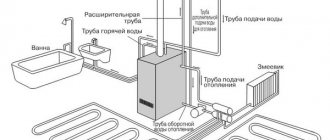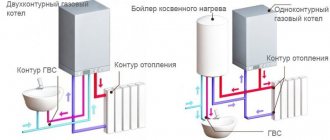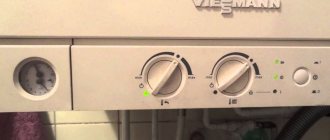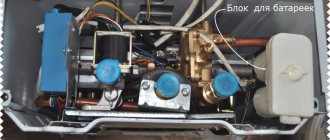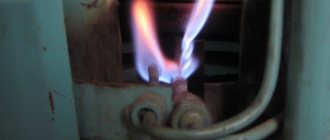Home |Useful articles |Double-circuit boiler in comparison with a single-circuit boiler and a gas water heater
Date: October 6, 2020
Comments: 0
In matters of water treatment in a private home, there is an eternal debate between universal and specialized approaches.
A universal view is to provide the home with heat and hot water using a double-circuit gas boiler that solves both problems simultaneously. The second option is specialization, when one unit (gas water heater) supplies hot water, and another (single-circuit boiler) handles home heating.
Specialists of the GradusPlus project, who have posted more than one material on their portal gradusplus.com about ways to save and optimize home heating, presented all the pros and cons of each of the schemes. They also determined why a single-circuit boiler and gas water heater are better and more comfortable, but not always.
Double-circuit gas boilers
Such boilers constructively separate the heating circuits of DHW and coolant, while sanitary water from the DHW circuit does not mix with technical water in the heating circuit. In our climate, they have two main operating modes:
- simultaneous maintenance of temperature in the hot water circuit and heating of the room in winter (or, if necessary, in cold summer);
- summer provision of hot water for household needs when heating is turned off (summer mode).
Operating modes can be controlled manually (for budget models) and automatically, depending on the situation outside the home (for advanced boilers). Double-circuit equipment is divided into two types: with a common or two separate heat exchangers.
Differences between boilers with one bithermal heat exchanger and two separate monothermal ones.
The best models of gas storage water heaters for 2019 – prices and customer reviews
As promised, we provide our readers with an independent rating of the best representatives in the class as of 2021 - from budget models to De Luxe class products.
Instantaneous water heater Electrolux NanoPlus 2.0
And our TOP opens with a budget geyser from the Swedish company Electrolux. This option is perfect for a small apartment, and its pleasant appearance and electronic display will perfectly complement the decor of any kitchen or bathroom.
| power, kWt | Productivity, l./min. | Combustion chamber type | Heat exchanger material | Type of ignition |
| 20 | 10 | Open | Copper | Electric (automatic) |
water heater Electrolux NanoPlus 2.0
Flow-through gas boiler Zanussi Fonte Glass La Spezia
The next nominee comes from Italy. The combination of price and quality in this product is almost ideal. In addition to excellent characteristics, the model from Zanussi boasts a spectacular appearance that is ideal for the kitchen.
| power, kWt | Productivity, l./min. | Combustion chamber type | Heat exchanger material | Type of ignition |
| 18,5 | 10 | Open | Copper | Electric (automatic) |
Zanussi Fonte Glass La Spezia
Instantaneous water heater Rinnai RW-14BF
The representative from the Land of the Rising Sun closes the top three best flow-through models. Both experts and buyers have known about the quality of their products for decades. In our case, the product is not only high-quality, but also profitable - its power is more than enough for a large family.
| power, kWt | Productivity, l./min. | Combustion chamber type | Heat exchanger material | Type of ignition |
| 29,4 | 14 | Closed | Stainless steel | Electric (automatic) |
water heater Rinnai RW-14BF
Gas storage water heater Ariston SGA 200 (liters)
Cumulative modifications are not so widely popular due to their size and features, but several representatives still managed to get into our rating. Among them, one of the most confident positions is occupied by the gas storage water heater Ariston SGA 200. The Italian brand is able to offer a colossal volume of heated water and responsible control over the gas level during operation.
| power, kWt | Productivity, l./min. | Combustion chamber type | Heat exchanger material/tank inner coating | Type of ignition |
| 8,65 | 4 | open | Steel/enamel | Piezo ignition |
Ariston SGA 200
Storage boiler Baxi SAG3 100 (liters)
Well, the “gold” of our TOP is confidently taken... again by a company from Italian masters! Their 100-liter gas storage water heater SAG 3 will be a reliable assistant during the most severe outages by water supply services. An excellent offer for a large private house that can easily provide hot water for at least four people.
| power, kWt | Productivity, l./min. | Combustion chamber type | Heat exchanger material/tank inner coating | Type of ignition |
| 4,5 | 9,7 | open | Stainless steel/enamel (titanium) | Piezo ignition |
boiler Baxi SAG3
Boilers with double heat exchanger
This is the most compact and inexpensive design solution. The gas burner heats one heat exchanger, divided into two independent sectors for hot water and coolant. One circuit is inside the other. They are united only by the metal of the converter and do not mix in any way.
However, there are also significant disadvantages of the bithermal design. To increase efficiency, the sectors of the circuits are located very close and different-temperature fluid in them can strain and deform the entire structure. Corrosion in this system is also increased and requires high-quality water and coolant, otherwise the narrow channels will simply become overgrown with scale and become clogged.
Flow-through
A instantaneous gas water heater is also used. In Russia, a flow-through wall-mounted water heater was more often installed; it used to be called a geyser. If anyone remembers, it was quite difficult to set fire to these units; you had to make sure that the flame did not go out and adjust the height of the flame manually. Modern analogues are easier to operate and less dangerous.
Boilers with two separate heat exchangers
Heating and hot water circuits in such structures have their own, spaced-apart heat exchangers. The burner heats the heat exchanger of the heating circuit, and the DHW circuit is heated by contact with the heating circuit as soon as the tap is opened at the point of hot water consumption.
Advantages and disadvantages of using double-circuit gas boilers
| Advantages | Flaws |
| They save space at home, due to the fact that all units are located in one, all the same compact equipment | The main disadvantage is that if there is a malfunction, the building is deprived of heating and hot water supply at the same time |
| The total cost of two heaters combined in one housing is less than the purchase of 2 devices. And in general, a double-circuit gas boiler is the cheapest way to organize hot water supply | Hot water consumption points should be close to the boiler, i.e. in houses with an area of no more than 350-400 m2. When they are placed remotely and turned on at the same time, the water temperature drops sharply and heat losses increase. And the prepared water travels a long way, which leads to a large delay in supply. |
| Connecting from one gas pipe and using one chimney makes installation and obtaining permits easier and cheaper | The design of double-circuit gas boilers is more complex, especially if the heat exchangers are not separate. The combination of a single-circuit boiler and a gas water heater is, on average, always more reliable |
| The influence of water heating on the heating system in the summer is difficult to avoid |
Cumulative
Gas storage water heaters are good at heating water for any need. The amount of heated water depends on the design of the water heater. Such water heaters are: horizontal, flat, floor. Thus, you can choose any one that fits into the dimensions and interior of the apartment. It is also important when choosing such a device to take into account the methods of air flow:
- Forced draft - devices are connected to a chimney leading outside.
- Natural draft - they require a constant supply of air and connection to a common chimney.
There is no need for a special electrical connection to such a water heater, but a chimney is required.
What is the difference between a system with a single-circuit boiler and a gas water heater?
Abandoning the universality of two heating circuits in favor of specialization leads to a significant simplification of the control system and an increase in its reliability.
This system allows:
- Autonomously heat a building using any coolant, regardless of hot water consumption.
- Heat the required amount of water while maintaining its temperature, regardless of distance from the boiler.
- Failure or shutdown of one of the systems as unnecessary does not entail consequences for the other circuit.
The disadvantages of this approach are already known:
- The total cost of installed equipment is significantly higher than with a universal scheme.
- The requirements of regulations SP 62.13330 (formerly SNiP 42-01-2002) complicate and make the project more expensive.
The rules for installing two gas appliances prohibit placing them on top of each other; equipment manufacturers indicate in the instructions the minimum distances between them. Regulation SP 62.13330 defines the minimum area of a room for joint installation of equipment up to 9 m2 and a ceiling height of more than 2.2 m, the gap under the door to the boiler room must be at least 5 cm. It is also worth noting the serious requirements for ventilation of the room.
Typical misleading photo. Above the floor-standing boiler there is a wall-mounted boiler, not a gas water heater. Subject to certain conditions, it is possible to install 2 boilers into one chimney, but not a gas water heater and a boiler.
The chimneys for both gas appliances must be separate; combining them completely violates the requirements of the regulations. Two gas connection points also make installation and obtaining permits more difficult and expensive.
Which equipment is better to choose?
When choosing a unit for heating a country house, cottage or apartment, consumers often find it difficult and cannot determine the model they need to purchase. Therefore, you need to at least briefly know the main characteristics and types of equipment.
Heating devices are represented by the following types:
- Single- and double-circuit units. The first ones are intended exclusively for hot water supply. The latter are equipped with 2 circuits, can heat the air in rooms and additionally provide water at the required temperature.
- With 1-2 heat exchangers. These are devices with bithermal, separate temperature sensors. The latter are durable and reliable due to their low sensitivity to water quality. When using bithermal models, anti-scale agents are required.
- Condensing units. Due to the high temperature of the exhaust gas, the equipment saves up to 16-18% of fuel when heating a house. The units are used when installing a “warm floor” system. The device achieves its highest efficiency at a temperature of about 40°C.
When purchasing heating equipment to heat your home, you need to focus on the planned load of the unit, the area of the premises, productivity and installation conditions. Additionally, other factors are taken into account, including the preferences and needs of the owners themselves.
If in doubt, it is better to consult a specialist, since replacing equipment will be costly and time-consuming.
Which is better: a double-circuit gas boiler or a single-circuit gas boiler?
Compliance with the regulations in an apartment in an apartment building does not provide the opportunity to choose between a double-circuit boiler and a boiler + boiler. There is usually no additional room for installing two gas units, even including the bathroom, since placing such equipment in it is legally prohibited.
It is possible to build a boiler room in a private house and it is quite possible to meet the requirements of SP 62.13330. The choice of method for organizing DHW depends on the budget and the availability of space in the boiler room.
If the budget is not so limited (at least from 50-55 thousand rubles for equipment and communications), and the premises allow you to meet the requirements described above, the choice is clear - a single-circuit boiler and a gas water heater. This scheme is more productive, reliable and practical/comfortable. Otherwise, a double-circuit gas boiler is quite justified; now their popularity has exceeded single-circuit models. The main thing is to approach the choice wisely, having studied all the criteria.
The further choice of equipment is determined by thermal engineering calculations: first to ensure the required temperature conditions, then to provide DHW. In practice, they often do not resort to complex calculations and use the norm: 1 kW per 10 m2 of area + 20-30% reserve.
Important parameters of a capacitive gas water heater - what to pay attention to
The first important point of our small study has been completed. But, asking the question “How to choose a gas water heater?”, one cannot ignore such a section as technical and operational characteristics. Let's take a closer look at the most important parameters:
Power and performance
For almost any household appliance, the most important indicator that reveals its full potential is the rated power. As in the case of an electric water heater, the hero of our review has a value measured in kilowatts.
In practice, another important characteristic—performance—depends on power. To more clearly confirm these words, we suggest that you familiarize yourself with the table of the dependence of two characteristics.
| Power value, kW | Maximum volume of water heated to 30 ºС, l./min. | Maximum volume of water heated to 50 ºС, l./min. |
| 20 | 13 | 6 |
| 26 | 16 | 8 |
| 30 | 18 | 9 |
Performance also has its own important parameter, and its name is storage capacity. Having studied the instructions, you can notice a direct relationship between how many liters the heater can hold and how long it will take for the water to be heated to a certain temperature.
Materials used + type of internal coating of the tank
Today, there are two most common materials for the manufacture of the internal tank of the device - ordinary steel coated with a layer of enamel, or “stainless steel”. The first option is cheaper and more durable, but is subject to rapid destruction due to corrosion. The second variation has good durability, but is more damaged by pressure drops in the system, and is also high in cost.
For the internal coating of the container, either the previously mentioned enamel is used (models with glass porcelain are also found), or spraying of various corrosion-resistant metals (titanium, molybdenum). Each version has its own useful life, and depends primarily on the intensity of use and heating temperature.
Combustion chamber type
As we said earlier, there are units with an open and closed combustion chamber, and each has its own strengths and weaknesses. The wrong choice of device will entail unnecessary costs, and may also completely fail to meet your goals and expectations. If you are not completely sure, it is better to give preference to a classic flow-through geyser - the risk will be minimal.
Ignition starting method
If you only have a modest amount of money or you want to completely control the operation of the water heater, it is better to take a model in which the gas is ignited with matches, a lighter or a piezoelectric element. If you want to save time and energy costs, then you should take a closer look at models with automatic start/shutdown.
Presence of sacrificial anode
To extend the service life of the device and improve its corrosion resistance, many manufacturers equip their “brainchildren” with a zinc or magnesium anode. During use, this element gradually “evaporates”, dissolving and preventing damage to the integrity of the tank. It is better to check in advance with the seller or on the manufacturer’s website about the presence of such “bells and whistles”.
Installation conditions
All installations of gas appliances require approval from gas services. To install a geyser with an open chamber, there are technical conditions that must be observed.
It will be very difficult to install a gas water heater yourself if you didn’t have one before. I'll explain why. It will be necessary to tie it to the main water and gas pipelines.
Therefore, currently in apartments, installation of instantaneous water heaters is done only in the kitchen. But at the same time, it cannot be installed above the gas stove itself.
But the main thing is the presence of a special hood. Previously, these speakers were installed in bathrooms. You can install the unit in the old place; the rules do not prohibit the use of speakers in the bathroom.


